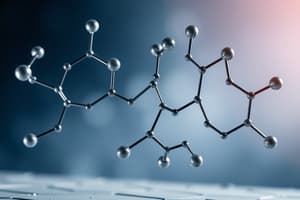Podcast
Questions and Answers
Which of the following is NOT a type of hydrocarbon?
Which of the following is NOT a type of hydrocarbon?
- Alkyne
- Alkane
- Amine (correct)
- Alkene
Which statement best describes stereoisomers?
Which statement best describes stereoisomers?
- Isomers with the same molecular weight but different connectivity.
- Molecules that differ in spatial orientation around a chiral center. (correct)
- Isomers that can be interconverted by rotation around single bonds.
- Compounds that have different molecular formulas.
Which type of organic functional group is characterized by the presence of a carbonyl group?
Which type of organic functional group is characterized by the presence of a carbonyl group?
- Ester
- Ketone (correct)
- Amine
- Alcohol
What is the typical effect of increasing molecular weight on the physical properties of hydrocarbons?
What is the typical effect of increasing molecular weight on the physical properties of hydrocarbons?
Given a monomer structure, what is the result of polymerization?
Given a monomer structure, what is the result of polymerization?
Flashcards are hidden until you start studying
Study Notes
Hydrocarbons
- Contain only carbon and hydrogen atoms
- Classified by the types of carbon-carbon bonds (single, double, triple) and the shape of the molecule (linear, branched, cyclic)
- Examples include alkanes, alkenes, alkynes, and cycloalkanes
Isomers
- Molecules with the same molecular formula but different structural arrangements
- Can be constitutional isomers, differing in the connectivity of atoms, or stereoisomers, differing in the 3-dimensional arrangement of atoms
- Example: Butane and isobutane are constitutional isomers, while cis- and trans-but-2-ene are stereoisomers
Predicting Physical Properties of Hydrocarbons
- Molecular weight is crucial for determining physical properties
- Higher molecular weight hydrocarbons have higher boiling points, melting points, and stronger intermolecular forces
- Branching decreases these properties (except melting point of alkanes with 5 or more carbons)
- Example: Octane (C8H18) has a higher boiling point than hexane (C6H14) because it has a larger molecular weight.
Organic Functional Groups
- Groups of atoms that determine the chemical reactivity of a molecule
- Include alcohols, aldehydes, ketones, carboxylic acids, amines, amides, and ethers
- Each functional group has a specific chemical formula and a unique set of properties
General Organic Reaction Types
- Common reactions include addition, substitution, elimination, and oxidation-reduction
- Addition reactions involve adding atoms or groups to a molecule with multiple bonds
- Substitution reactions involve replacing one atom or group with another
- Elimination reactions involve removing an atom or group from a molecule
- Oxidation-reduction reactions involve the transfer of electrons between molecules
Chiral Molecules and Stereoisomers
- Chiral molecules have a non-superimposable mirror image
- They contain a chiral center, typically a carbon with four different substituents
- Stereoisomers of chiral molecules differ in their spatial arrangement
- Enantiomers are stereoisomers that are mirror images of each other, while diastereomers are stereoisomers that are not mirror images
- The presence or absence of chirality can significantly affect the biological activity of molecules
Polymers
- Large molecules made by joining together many smaller repeating units called monomers
- The structure of the monomer dictates the properties and characteristics of the polymer
- Examples include polyethylene (monomer: ethylene), polypropylene (monomer: propene), and nylon (monomer: diamine and dicarboxylic acid)
Amino Acids and Peptides
- Amino acids are the building blocks of proteins
- They have a central carbon atom bonded to an amino group (NH2), a carboxyl group (COOH), a hydrogen atom, and a side chain (R group)
- Peptides are chains of amino acids linked by amide bonds
- Different amino acid sequences determine the structure and function of proteins
Studying That Suits You
Use AI to generate personalized quizzes and flashcards to suit your learning preferences.




